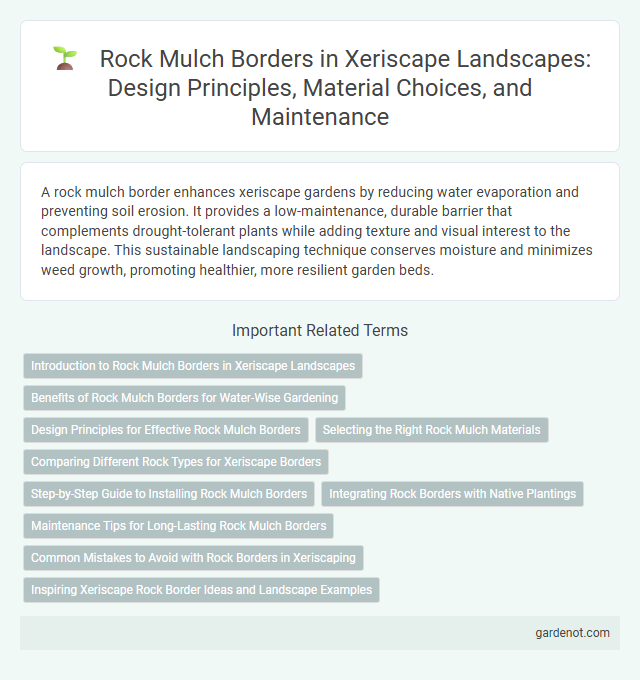A rock mulch border enhances xeriscape gardens by reducing water evaporation and preventing soil erosion. It provides a low-maintenance, durable barrier that complements drought-tolerant plants while adding texture and visual interest to the landscape. This sustainable landscaping technique conserves moisture and minimizes weed growth, promoting healthier, more resilient garden beds.
Introduction to Rock Mulch Borders in Xeriscape Landscapes
Rock mulch borders serve as an effective xeriscape landscaping solution by reducing soil moisture evaporation and limiting weed growth. These borders consist of various-sized stones or gravel that create a durable, low-maintenance barrier around plants and garden beds. Integrating rock mulch borders enhances water conservation efforts while adding texture and visual interest to drought-tolerant designs.
Benefits of Rock Mulch Borders for Water-Wise Gardening
Rock mulch borders significantly reduce soil evaporation, helping retain moisture in xeriscape gardens and minimizing irrigation needs. Their porous nature allows rainwater to seep directly into the ground, enhancing water absorption and preventing runoff. Durable and low-maintenance, rock mulch borders also inhibit weed growth, promoting healthier plants and conserving water resources.
Design Principles for Effective Rock Mulch Borders
Rock mulch borders enhance xeriscape design by promoting water conservation and reducing soil erosion. Effective design principles include selecting appropriate rock sizes to facilitate drainage, creating clean edges for visual appeal, and positioning borders to direct water flow toward plant roots. Incorporating contrasting textures and colors with native drought-tolerant plants maximizes both functionality and aesthetic value in sustainable landscaping.
Selecting the Right Rock Mulch Materials
Selecting the right rock mulch materials for xeriscape borders involves considering factors such as size, color, and durability to enhance water conservation and aesthetic appeal. Gravel, decomposed granite, and crushed stone are popular choices due to their excellent drainage properties and resistance to erosion. Opting for locally sourced rock mulch reduces environmental impact and ensures compatibility with the region's climate and soil conditions.
Comparing Different Rock Types for Xeriscape Borders
Granite, river rock, and decomposed granite are popular choices for xeriscape rock mulch borders due to their durability and water retention properties. Granite offers strength and a natural aesthetic with minimal fading, while river rock provides smooth textures that reduce soil erosion and enhance drainage. Decomposed granite compacts well to create a stable surface, making it ideal for walkways and edging in drought-tolerant landscapes.
Step-by-Step Guide to Installing Rock Mulch Borders
Start by outlining the desired border using landscape spray paint or a garden hose to define the shape accurately. Excavate the perimeter to a depth of 3-4 inches, removing grass and weeds before laying down landscape fabric to prevent future growth. Finally, evenly spread a 2-3 inch layer of decorative rock mulch along the border, ensuring it stays contained and enhances water-efficient xeriscaping principles.
Integrating Rock Borders with Native Plantings
Integrating rock mulch borders with native plantings enhances water conservation by reducing evaporation and limiting weed growth while complementing drought-tolerant species like sagebrush and yucca. Rock borders create natural, low-maintenance barriers that support native plant health and soil stability in xeriscape gardens. This combination maximizes ecosystem harmony and promotes sustainable landscape design in arid environments.
Maintenance Tips for Long-Lasting Rock Mulch Borders
Rock mulch borders require regular inspection to prevent weed growth and maintain their clean appearance; applying a pre-emergent herbicide can significantly reduce unwanted plants. Periodically raking the rock mulch helps to redistribute materials evenly while removing debris that can decompose and harm soil quality. Replenishing the rock mulch every few years preserves the border's aesthetic and functional benefits, ensuring effective moisture retention and erosion control.
Common Mistakes to Avoid with Rock Borders in Xeriscaping
Rock mulch borders in xeriscaping often suffer from common mistakes such as using rocks that are too small, which can easily scatter and require frequent maintenance. Improper installation without a weed barrier leads to weed growth undermining the aesthetic and water efficiency of the xeriscape design. Overloading the border with thick rock layers can prevent water from reaching plant roots, negating the water-saving benefits of xeriscaping.
Inspiring Xeriscape Rock Border Ideas and Landscape Examples
Rock mulch borders create striking visual contrasts while conserving water in xeriscape landscapes, showcasing a variety of textures and colors that enhance drought-tolerant plantings. Popular designs include layered pebble paths, river rock outlines, and rugged boulder arrangements that define garden beds and walkways with low maintenance and high aesthetic appeal. Incorporating native succulents and ornamental grasses alongside rock mulch borders emphasizes sustainable landscaping and promotes natural habitat resilience.
Rock mulch border Infographic

 gardenot.com
gardenot.com